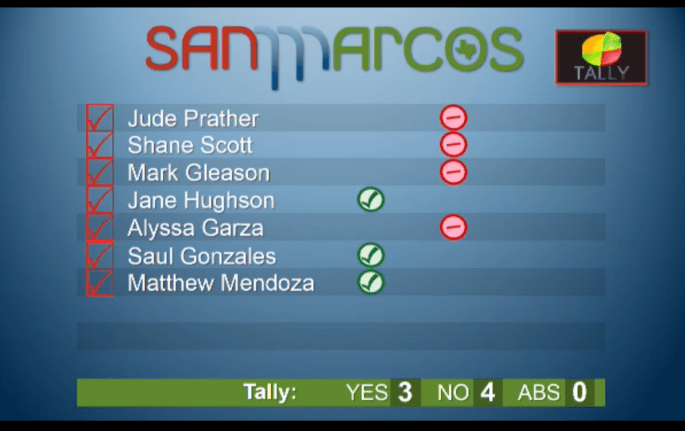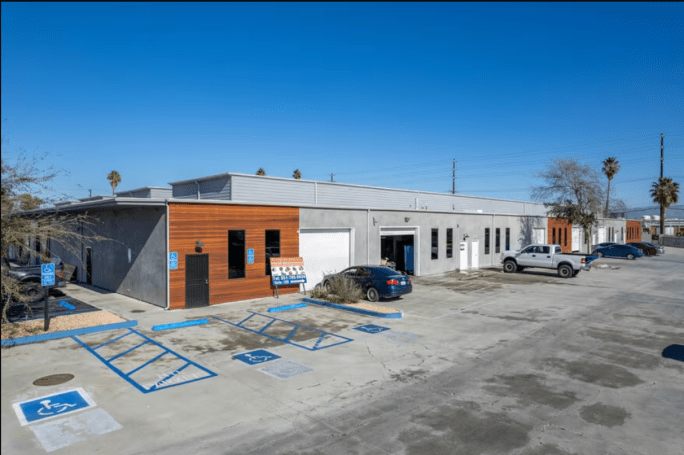Item 15: The Downtown Area Plan
The Downtown Area Plan is more than just the CM Allen District, but that’s definitely the part that sucks up all the oxygen in the room. (Discussed here last time.)
Still, let’s take a moment to pay attention to the rest:

And here are the major points:

The thing is: downtown is already owned and zoned. You can’t demand or legislate hardly anything. All you can do is entice and form partnerships and collaborate with the people who run the things located there.
So let’s move onto the CM Allen District, which we discussed last time:

There was a Downtown Area Plan committee, who came up with Option 1:
Option 1:
Five Story Loaves of Bread:

Similarly to VisionSMTX, the shadow subcommittee of P&Z plus Jane Hughson was horrified, and rewrote it.
Hence Option 2:

Given that the city doesn’t actually own all that land, the Planning Department tried to thread the needle and come up with a compromise option:
Option 3:
Colorful, vibrant, smaller loaves of bread:
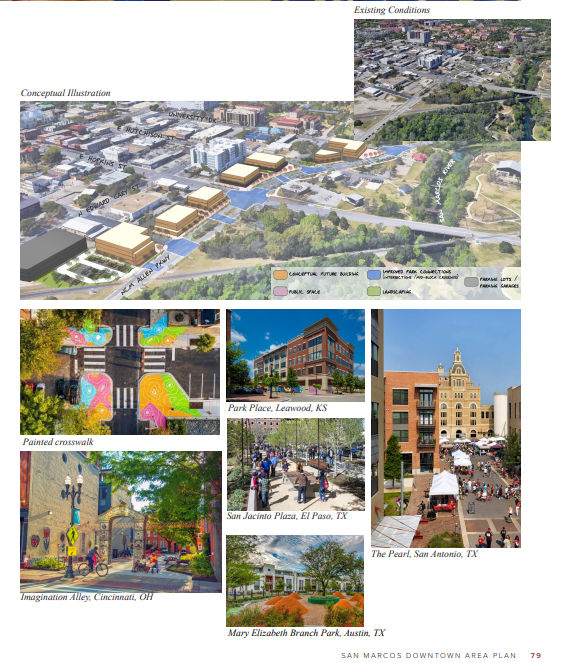
At P&Z, we heard about the unaffordability of Option 2. P&Z voted for Option 2 anyway.
This time the staff presentation spends even longer on the complete unaffordability of it:
- Basically, downtown land is worth much more than anywhere else in town.
- Right now, the 6.25 acres are mostly undeveloped, but they bring in this much taxable revenue:
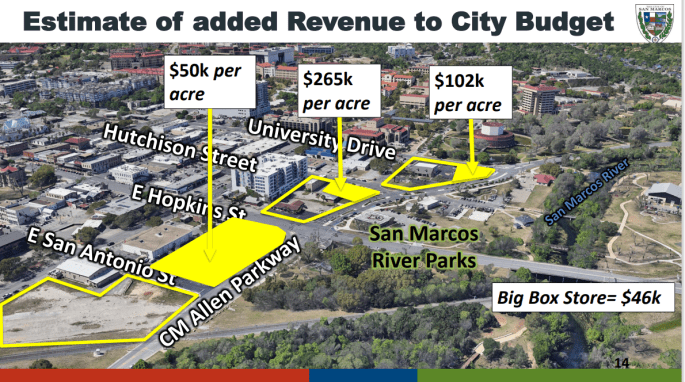
The whole thing is 6.25 acres, so I’m going to ballpark the yearly revenue at $456K for the three lots marked. A community member says that if they were developed, they’d pull in $3 million/year for the city. Maybe?
No one can really say how much it would cost to acquire the parks, but if we had to say, staff puts the market value at $27 million dollars.
The city staff are always so professional, and so they presented all options neutrally, but I definitely got whiffs of Springfield Monorail from Option B:

Besides the magical thinking of the price tag, there’s also serious equity issues here.
Here is how the current parks are distributed throughout the city:
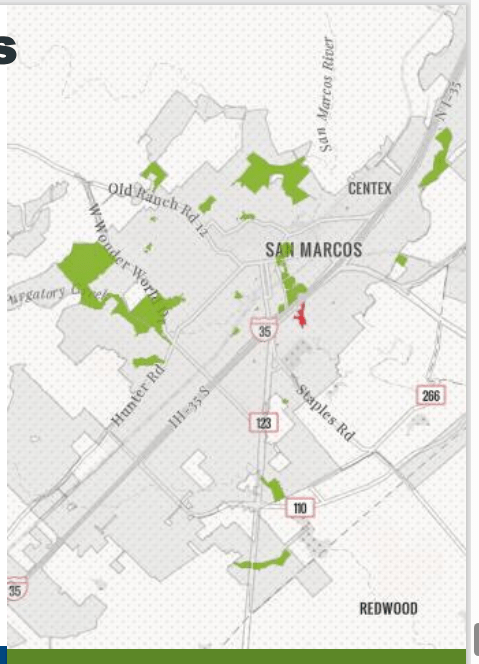
You may notice that there’s barely anything east of 35. People who live east of 35 have noticed this too, and are not amused. (They’ve also noticed a bunch of other patterns of systematic disregard. Isn’t that something!)
So what does the public think?
MO-NO-RAIL! MO-NO-RAIL! Ahem.
- Giant student housing will make parking way worse downtown.
- There’s a shallow water table under CM Allen, and drilling into the rock wil fracture it.
- If Texas State buys this land, we’re hosed.
- The procedure was not democratic. Option 2 preys on emotions.
- There are serious accessibility issues downtown for people in wheelchairs. This plan doesn’t address any of that.
- The college students run downtown and grown ups don’t feel welcome.
- We can find much better ways to spend $27 million dollars than this.
- Car dependency is bad, it’s better to put more housing in walkable areas like downtown.
In actuality: there are three in favor of Option 2, five opposed, and one speaking on accessibility issues.
Council discussion:
Mark Gleason goes first:
- He loves the vision of #2. He wishes we could afford it.
- There’s absolutely no way he can go face constituents on the East Side and tell them he voted to spend $27 million on more West side parks.
- It’s already zoned, it’s not undeveloped like the Woods
- This won’t stop flooding.
- Not ideal, but #3 is best. We must to something to help the rest of town.
I certainly agree with all of that! He also talks about how there’s going to be a trail around the whole city, which is a reference to the Elsik Tract.
(I can see the marketing now! “A River Runs Through Us, That Historic Trail Also Runs Through Us, and a Loop Runs Around Us.” Practically a spaghetti bowl of significance!)
Jane goes next: She literally says “I need to do some ‘splaining,” which is endearing.
- Her ‘splaining: The graphics freaked her out, and she wanted some green space. Never pictured golf course style mock up. Never said “Eminent Domain” or millions of city money.
- The idea was that if you don’t explicitly ask for green space, you’ll get zero. If you do ask, maybe you’ll get a little.
Jude: There are better places to turn into parks than this. Could City Hall move here? Hotel, civic space?
Alyssa: I don’t like any of them, but I agree with Jude and Mark.
Shane: What about a splash pad downtown? I’m here for families! Families first! These are the last tracts along the river. Option 2!
Saul: I’m born and raised in San Marcos. There were no skyscrapers back then. Whenever I talk to anyone, they say “Why are there so many skyscrapers downtown? Why is there so much student housing?” That’s not San Marcos. Plus, it’s a slippery slope. What’s next, high rises all the way to 35? What if Texas State buys it? They don’t pay taxes or fees! It’s for the kids. Bring back how it was!
[Side Note: “Why is there so much student housing?” Because the town loses their goddamn minds if students live anywhere else. Students are actually people, and they’re entitled to live in this town.
Sometimes students act like jerks! But so do rich people, and also middle-class people, and also poor people. People are jerks.]
Matthew: I had been a big fan of #2. Rio Vista Relief! But paid parking is coming. Where would this park’s parking be?
We had a community meeting with Blanco Gardens on crime. Wasn’t well attended, and just me and Mark. They kept saying, “Why does the west get EVERYTHING?” Park distribution is not fair. East side is always neglected.
Matthew gave this huge impassioned speech about the plight of the east side, and then finished by saying, “And that’s why I’m on the fence!” which made me laugh. Way to undercut your own passion.
Saul: Cape’s Dam is coming to the east side!
Matthew: But not, like, anytime soon.
The Vote on the CM Allen District:
Love me some Option 3!: Mark Gleason, Jane Hughson, Alyssa Garza, Matthew Mendoza, Jude Prather
Option 3 Gives Me a Sad: Shane Scott, Saul Gonzales
So there you have it.
The entire downtown plan will get revised to incorporate Option 3, and then will come back on November 6th for a final vote.
…
Item 12: Sights & Sounds
Apparently people ask Alyssa every year to keep an eye on S&S. The former city manager gave her the runaround when she asked for documentation. She asks if she could please get some straight answers. She’s told “no problem!”
…
Item 16: Land Development Code:
Last meeting, we were going to kick this back for two months, to give committees a chance to meet. Now the planning department is asking if we could please just pass it, since it’s holding up a bunch of stuff, and they promise the committees will all meet promptly.
Sure: 7-0. So that’s that.


